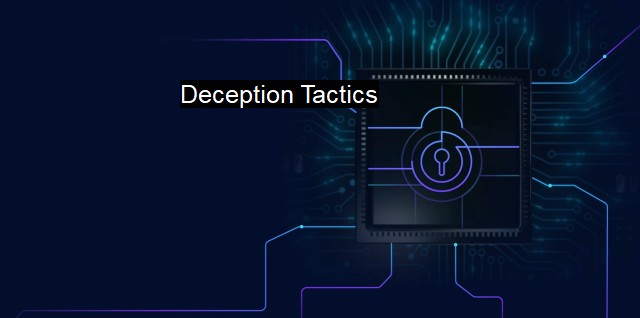What are Deception Tactics?
Unveiling Deception Tactics: The Proactive Approach to Securing Your Cyber Infrastructure
"Deception Tactics" refers to the stratagems employed by security professionals to deceive, distract or divert attackers. These deception tactics typically aim to mislead attackers to impose additional computational demands, trigger uncertainty and confusion, or induce mistakes in decision-making with the ultimate objective of impeding or entirely precluding successful cyber-attacks.One fundamental premise of deception tactics in cybersecurity and antivirus is epitomized in the art of phishing. The allure of phishing lies in its cunning play on human gullibility and propensity for mistakes. Phishing campaigns typically involve sending deceptive emails containing malicious links or attachments. When unwary individuals click on these links or open attachments, they unwittingly install malware on their system, providing attackers undeterred access to sensitive data. Evidently, phishing leverages deception to exploit vulnerabilities in human decision-making, rather than in machine coding.
Aside from its widespread use by attackers, deception is increasingly employed as a tool for proactive defence. For instance, cybersecurity professionals seek to deceive potential attackers through various techniques such as honeypots, honeytokens, and breadcrumb trails.
Honeypots are bogus systems or data repositories created to imitate a legitimate part of an organisation’s network with the sole intent of attracting and entrapping cybercriminals. Honeypots are typically constructed with intentional vulnerabilities that make them an appealing target. When baited, attackers reveal their attack methodologies and patterns, information crucial for designing robust cybersecurity tools and update efficient antivirus software.
Honeytokens are fake data that appear valuable to attackers but serve no purpose for the legitimate user. The moment attackers interact with honeytokens, a cybersecurity team can trigger alerts and subsequently logs all attacker activities for analysis and tracking.
The breadcrumb trail tactic involves leaving enticing but misleading clues scattered across the targeted network. Decoy information distracts attackers, driving them into a false sense of achievement while ailing them into revealing their location and tactics.
Deception tactics can lead to direct and indirect benefits for organizations. Direct advantages include early identification of breaches, improved threat understanding, reduced false positives, and misleading attackers. Indirectly, the awareness and potential threat of deception can deter attackers. Deception multiplies the complexity of the cyber attack process, increasing the effort necessary for success and reducing the prospective benefits for an attacker.
In the swiftly evolving world of cyber threats, antivirus software outfitted with a deception technology layer significantly boosts securer resilience against advances attack mechanisms. Such antivirus solutions lean on deceptive tactics to develop exceptionally nuanced protection layers offering extensive context about threats. The ability to employ deception in the security blend helps for more dynamic security adaptations that better confirm potential hazards before they escalate into attacks.
Importantly, getting started with cyber deception tactics doesn't necessitate an extensive overhaul of existing cyber infrastructure. Deception technology can be seamlessly integrated into existing security systems, complementing standard defense mechanisms with traps and misdirection techniques, devised to flag suspicious activities and isolate potential threats.
Therefore, with escalating sophistication in cybercrime methodologies, incorporating deception tactics into defence countermeasures makes technology infrastructure more secure by adding a decoy layer that enhances threat detection and containment capabilities. Despite deception tactics not being an all-in-one solution for cyber threats, they represent a significant enhancement of comprehensive cybersecurity setups, tweaking the game to favour defenders, and putting prospective cyber adversaries on notice.

Deception Tactics FAQs
What are deception tactics in cybersecurity?
Deception tactics in cybersecurity are techniques used to mislead or trick attackers. These tactics can range from honeypots and honeynets to targeted disinformation campaigns. The goal of deception is to distract, delay, or confuse attackers, making it harder for them to achieve their objectives.How can deception tactics be used in antivirus software?
Antivirus software can use deception tactics to detect malware and other threats. This may involve setting up virtual machines or sandbox environments to trick malware into revealing itself. Deception can also be used to disguise security measures or create false positives, which can help deter attackers and give security teams more time to respond.What are some common types of deception tactics used in cybersecurity?
Some common types of deception tactics used in cybersecurity include honeypots, honeynets, honeytokens, and decoy networks. Honeypots are servers or systems designed to attract attackers, while honeynets are networks of honeypots that mimic a real network. Honeytokens are bait information, such as fake login credentials, that can be used to detect attackers. Decoy networks are fake networks set up to distract and mislead attackers.Are deception tactics effective in cybersecurity?
Deception tactics can be effective in cybersecurity, but they are not foolproof. Attackers can often detect deception if they are experienced and skilled. Additionally, deception tactics can be resource-intensive and may require significant time and effort to set up and maintain. However, when used correctly, deception tactics can help improve overall security posture and give defenders an advantage in detecting and responding to threats.| | A | | | B | | | C | | | D | | | E | | | F | | | G | | | H | | | I | | | J | | | K | | | L | | | M | |
| | N | | | O | | | P | | | Q | | | R | | | S | | | T | | | U | | | V | | | W | | | X | | | Y | | | Z | |
| | 1 | | | 2 | | | 3 | | | 4 | | | 7 | | | 8 | | |||||||